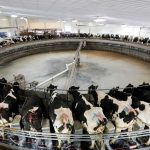
Global disruptions caused by the novel coronavirus that causes COVID-19 disease have reduced demand for dairy overseas and in the U.S., and milk prices are declining as a result.
“We’re seeing significant impacts right now,” said Agri-Mark Chief Economist Catherine de Ronde during a phone interview late last week. “It’s been happening for about six weeks.”
Boston Blend milk prices climbed steadily in the last quarter of 2019, from $18.72 per hundredweight (cwt) in October to $19.28 cwt in December, but the coronavirus wiped out those gains in January, as prices fell back to $18.78.
And they are forecast to decline even more — from $18.38 in February (actual numbers have not yet been released by the Northeast Marketing Federal Milk Order) to $17.66 in April.
“I model prices monthly,” de Ronde explained. “Six weeks ago I forecast a 2020 average of $19.80 to $19.90. This is a fairly good price — $1.50 to $1.70 higher than in 2019. That would have meant a fairly positive year (for dairy farmers).”
But, de Ronde said, “if I were to do that forecast today, I’d drop it by $1.70 or $1.80, which is a big drop for just six weeks.”
Recent declines in milk prices came just as farmers were hoping to climb out of an unusually long five-year slump.
“This was the year when the stars were supposed to align for us,” de Ronde said, “or at least be a better year.”
Whereas the five-year average Boston Blend milk price from 2010 to 2014 was $20.14 per hundredweight, the five-year average from 2015 to 2019 was $16.94 — a decline of $3.20, or 15.8%.
Vermont dairies tend to get $0.65 less per hundredweight than the posted Boston Blend price, so depressed prices hit home particularly hard. Between 2015 and 2019, the state lost 176 dairy farms.
Recent price moves are in part the result of pre-existing issues, de Ronde acknowledged.
When the Trump administration imposed tariffs on Chinese goods in 2018, China imposed retaliatory tariffs against U.S. imports. After the Trump administration lifted Mexican exemptions from some existing tariffs, Mexico also imposed tariffs on some U.S. dairy. That’s a problem for Vermont dairies because exports reduce oversupply in the U.S. and thus can raise prices here, de Ronde to the Independent last summer. So, without the exports, there is an oversupply of milk in the U.S.
“We rely very heavily on exports to move milk out of the marketplace when there is an excess,” de Ronde said in July.
What was already a problem because of the tariffs has been made significantly worse — at least in the short term — by the coronavirus.
First reported in Hubei Province, China, on Dec. 31, the coronavirus that causes COVID-19 was characterized as a “pandemic” by the World Health Organization this past Wednesday, with more than 100,000 cases confirmed in more than 100 countries.
At this time China is importing less milk from the United States, in part because coronavirus-related quarantines and disrupted supply chains have reduced access to products, de Ronde said last week. In some cases the demand has been eliminated altogether, as people narrow their consumption to just the local staples.
In the U.S., a lot of the price impacts are fear-based, de Ronde said.
Demand is actually going up in some places, as concerned citizens buy extra provisions.
“It’s a little bit like people stocking up before a hurricane.”
But de Ronde is concerned about further declines, she said.
“New England tends to benefit from the fluid milk market to more of an extent than in other regions (of the United States),” she explained. “If schools are shut down, that could have more of an impact on prices here than in other places.”
While there is a lot of room for concern, de Ronde said that so far the market seems to be treating this as a short-term blip.
“Things looked pretty positive before the virus, so it could get back to that trajectory,” she said. “Signs are pointing to opportunities for exports after this is resolved.”

























